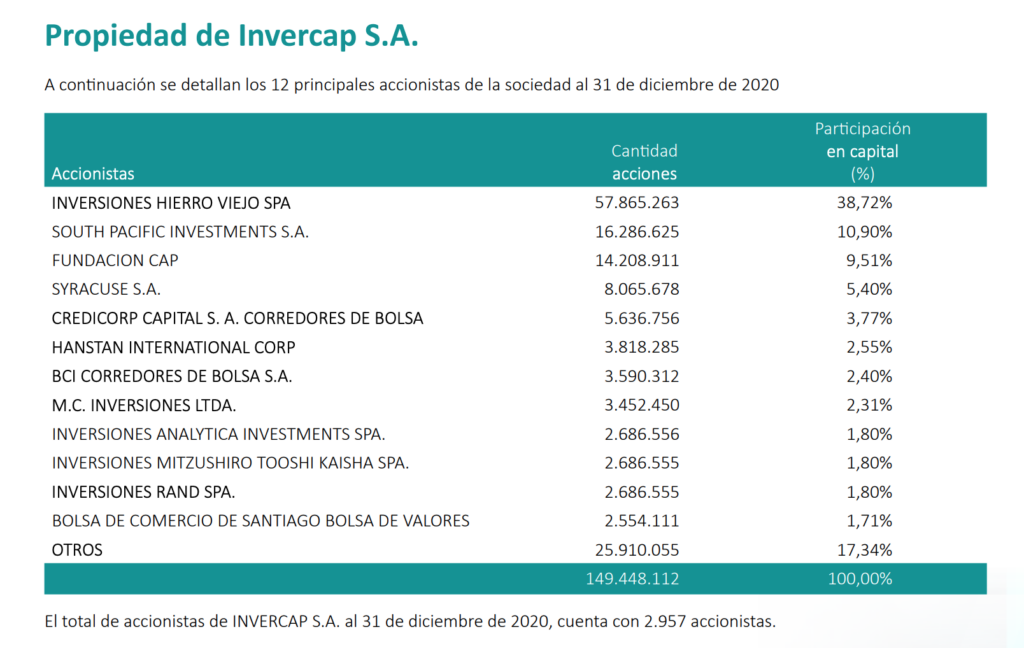Common Stock: Invercap
Current Market Price: $4.01 USD ($3,100 CLP)
Market Capitalization: $599.3 million USD
*All values in this article are expressed in United States Dollars (USD) unless otherwise noted.
**The bulk of this analysis is based on the company’s most recent audited financial report, which can be found by following this link.

Invercap Stock – Summary of the Company
Invercap is a publicly traded investment holding company that was founded to be the investment division of CAP S.A., one of the leading steel and mining companies in Chile. Invercap has investments across several industries, including steel, mining, real estate, petrochemicals. However their main focus is renewable energy.
Invercap was founded in 1994 and is headquartered in Santiago, Chile.
Revenue and Cost Analysis
Invercap had total revenue from ordinary operations (renewable energy) of $4.7 million in 2020, a significant decrease from $7.4 million in 2019. Their COGS in 2020 was $1.7 million, representing a gross margin 65%, also a decrease compared to 69% the previous year.
Balance Sheet Analysis
Invercap has a decent balance sheet. They have a strong base of long term assets and low liability levels. However their near term liquidity position is not strong.
Debt Analysis
As of year-end 2020 the company has $75.7 million in total debt outstanding, $27.9 million of which is classified as current.
Invercap Stock – Share Dynamics and Capital Structure
As of year-end 2020 the company has 149.4 million common shares outstanding.
The company’s 12 largest shareholders own around 83% of the company.

Dividends
The company has paid a dividend every year since 2003. In 2020 Invercap paid total dividends of $0.062 cents per share. At the current market price this implies a dividend yield of 1.5%.
Invercap Stock – 3 Metrics to Consider
Debt to Equity Ratio
Total Liabilities/Total Share Holder Equity
$103.8 million / $711.2 million = .15
A debt to equity ratio of .15 indicates that Invercap uses very little debt in its capital structure, and relies mostly on equity financing for funding.
Working Capital Ratio
Current Assets/Current Liabilities
$47.3 million / $53.5 million = .88
A working capital ratio of .88 indicates a weak liquidity position. Investors should monitor the company’s liquidity position closely for any further deterioration.
Price to Book Ratio
Current Share Price/Book Value per Share.
$4.01 / $4.76 = .84
Invercap has a book value per share of $4.76. At the current market price this implies a price to book ratio of .84, meaning the company’s stock currently trades at a discount to the book value of the company.
Invercap Stock – Summary and Conclusions
Invercap is an interesting investment opportunity. They have a diversified investment portfolio and are focusing heavily on renewable energy investments. The company’s long term financials are sounds, however heir near term liquidity position needs to be monitored. Management has returned capital to shareholders via a dividend every year since 2003.
I am intrigued by the company as a long term buy and hold investment .But I need to dig deeper into some of the company’s major investments before I can draw any conclusions.
Investors can also consider Chilean fishing company BluMar.
Disclaimer
This is not investment advice. Nothing in this analysis should be construed as a recommendation to buy, sell, or otherwise take action related to the security discussed. If I own a position in the security discussed, I will clearly state it.
This is not intended to be a comprehensive analysis and you should not make an investment decision based solely on the information in this analysis. I hope this serves as a useful starting point for a more comprehensive analysis, and hopefully draws attention to aspects of the company that were overlooked or merit further investigation. This is by no means intended to be a complete analysis. Again, this is not investment advice, do your own research.